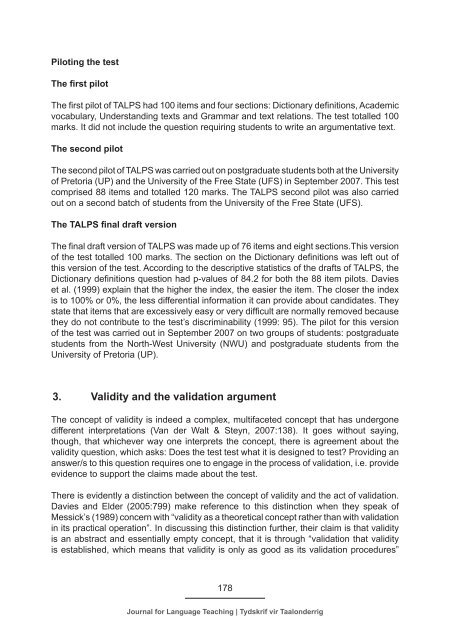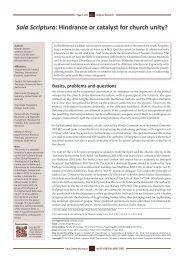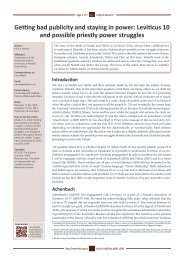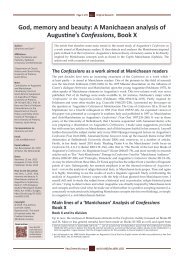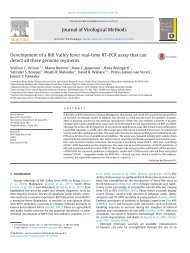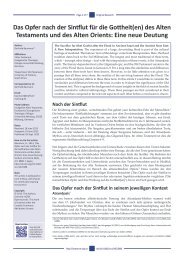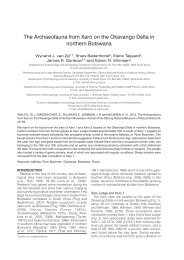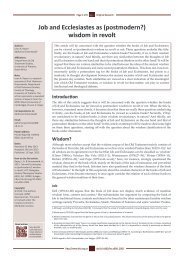View/Open - University of Pretoria
View/Open - University of Pretoria
View/Open - University of Pretoria
Create successful ePaper yourself
Turn your PDF publications into a flip-book with our unique Google optimized e-Paper software.
Piloting the test<br />
The first pilot<br />
The first pilot <strong>of</strong> TALPS had 100 items and four sections: Dictionary definitions, Academic<br />
vocabulary, Understanding texts and Grammar and text relations. The test totalled 100<br />
marks. It did not include the question requiring students to write an argumentative text.<br />
The second pilot<br />
The second pilot <strong>of</strong> TALPS was carried out on postgraduate students both at the <strong>University</strong><br />
<strong>of</strong> <strong>Pretoria</strong> (UP) and the <strong>University</strong> <strong>of</strong> the Free State (UFS) in September 2007. This test<br />
comprised 88 items and totalled 120 marks. The TALPS second pilot was also carried<br />
out on a second batch <strong>of</strong> students from the <strong>University</strong> <strong>of</strong> the Free State (UFS).<br />
The TALPS final draft version<br />
The final draft version <strong>of</strong> TALPS was made up <strong>of</strong> 76 items and eight sections.This version<br />
<strong>of</strong> the test totalled 100 marks. The section on the Dictionary definitions was left out <strong>of</strong><br />
this version <strong>of</strong> the test. According to the descriptive statistics <strong>of</strong> the drafts <strong>of</strong> TALPS, the<br />
Dictionary definitions question had p-values <strong>of</strong> 84.2 for both the 88 item pilots. Davies<br />
et al. (1999) explain that the higher the index, the easier the item. The closer the index<br />
is to 100% or 0%, the less differential information it can provide about candidates. They<br />
state that items that are excessively easy or very difficult are normally removed because<br />
they do not contribute to the test’s discriminability (1999: 95). The pilot for this version<br />
<strong>of</strong> the test was carried out in September 2007 on two groups <strong>of</strong> students: postgraduate<br />
students from the North-West <strong>University</strong> (NWU) and postgraduate students from the<br />
<strong>University</strong> <strong>of</strong> <strong>Pretoria</strong> (UP).<br />
3. Validity and the validation argument<br />
The concept <strong>of</strong> validity is indeed a complex, multifaceted concept that has undergone<br />
different interpretations (Van der Walt & Steyn, 2007:138). It goes without saying,<br />
though, that whichever way one interprets the concept, there is agreement about the<br />
validity question, which asks: Does the test test what it is designed to test? Providing an<br />
answer/s to this question requires one to engage in the process <strong>of</strong> validation, i.e. provide<br />
evidence to support the claims made about the test.<br />
There is evidently a distinction between the concept <strong>of</strong> validity and the act <strong>of</strong> validation.<br />
Davies and Elder (2005:799) make reference to this distinction when they speak <strong>of</strong><br />
Messick’s (1989) concern with “validity as a theoretical concept rather than with validation<br />
in its practical operation”. In discussing this distinction further, their claim is that validity<br />
is an abstract and essentially empty concept, that it is through “validation that validity<br />
is established, which means that validity is only as good as its validation procedures”<br />
178<br />
Journal for Language Teaching | Tydskrif vir Taalonderrig


